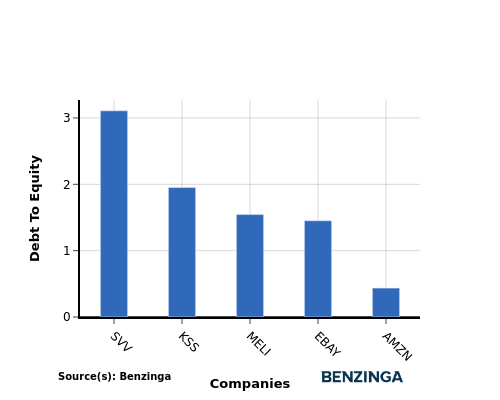In-Depth Analysis: Amazon.com Versus Competitors In Broadline Retail Industry
In the ever-evolving and intensely competitive business landscape, conducting a thorough company analysis is of utmost importance for investors and industry followers. In this article, we will carry out an in-depth industry comparison, assessing Amazon.com (NASDAQ:AMZN) alongside its primary competitors in the Broadline Retail industry. By meticulously examining key financial metrics, market positioning, and growth prospects, we aim to offer valuable insights to investors and shed light on company's performance within the industry.
Amazon.com Background
Amazon is the leading online retailer and marketplace for third party sellers. Retail related revenue represents approximately 75% of total, followed by Amazon Web Services' cloud computing, storage, database, and other offerings (15%), advertising services (5% to 10%), and other the remainder. International segments constitute 25% to 30% of Amazon's non-AWS sales, led by Germany, the United Kingdom, and Japan.
| Company | P/E | P/B | P/S | ROE | EBITDA (in billions) | Gross Profit (in billions) | Revenue Growth |
|---|---|---|---|---|---|---|---|
| Amazon.com Inc | 37.35 | 7.96 | 3.79 | 5.79% | $36.48 | $78.69 | 8.62% |
| Alibaba Group Holding Ltd | 16.11 | 2.04 | 2.09 | 1.23% | $21.8 | $90.83 | 6.57% |
| PDD Holdings Inc | 11.96 | 3.45 | 2.95 | 4.59% | $16.09 | $54.73 | 10.21% |
| MercadoLibre Inc | 58.53 | 24.10 | 5.39 | 10.56% | $0.92 | $2.77 | 36.97% |
| Coupang Inc | 224.21 | 13.04 | 1.85 | 2.53% | $0.36 | $2.32 | 11.16% |
| JD.com Inc | 8.13 | 1.47 | 0.30 | 4.6% | $14.27 | $47.85 | 15.78% |
| eBay Inc | 19 | 7.36 | 3.76 | 9.95% | $0.77 | $1.86 | 1.13% |
| Ollie's Bargain Outlet Holdings Inc | 41.50 | 4.78 | 3.56 | 2.78% | $0.07 | $0.24 | 13.35% |
| Vipshop Holdings Ltd | 8.15 | 1.45 | 0.56 | 4.85% | $2.45 | $6.08 | -4.98% |
| Dillard's Inc | 12.86 | 3.91 | 1.13 | 8.97% | $0.26 | $0.69 | -1.64% |
| MINISO Group Holding Ltd | 16.07 | 3.64 | 2.22 | 3.98% | $0.65 | $1.96 | 18.89% |
| Macy's Inc | 6.17 | 0.74 | 0.15 | 0.84% | $0.31 | $2.0 | -4.14% |
| Savers Value Village Inc | 71.64 | 3.76 | 1.07 | -1.13% | $0.03 | $0.2 | 4.51% |
| Kohl's Corp | 9.56 | 0.31 | 0.07 | -0.4% | $0.23 | $1.4 | -4.41% |
| Hour Loop Inc | 170 | 10.28 | 0.43 | 11.93% | $0.0 | $0.01 | 4.68% |
| Average | 48.13 | 5.74 | 1.82 | 4.66% | $4.16 | $15.21 | 7.72% |
By closely studying Amazon.com, we can observe the following trends:
-
At 37.35, the stock's Price to Earnings ratio is 0.78x less than the industry average, suggesting favorable growth potential.
-
With a Price to Book ratio of 7.96, which is 1.39x the industry average, Amazon.com might be considered overvalued in terms of its book value, as it is trading at a higher multiple compared to its industry peers.
-
The Price to Sales ratio of 3.79, which is 2.08x the industry average, suggests the stock could potentially be overvalued in relation to its sales performance compared to its peers.
-
The Return on Equity (ROE) of 5.79% is 1.13% above the industry average, highlighting efficient use of equity to generate profits.
-
Compared to its industry, the company has higher Earnings Before Interest, Taxes, Depreciation, and Amortization (EBITDA) of $36.48 Billion, which is 8.77x above the industry average, indicating stronger profitability and robust cash flow generation.
-
Compared to its industry, the company has higher gross profit of $78.69 Billion, which indicates 5.17x above the industry average, indicating stronger profitability and higher earnings from its core operations.
-
With a revenue growth of 8.62%, which surpasses the industry average of 7.72%, the company is demonstrating robust sales expansion and gaining market share.
Debt To Equity Ratio

The debt-to-equity (D/E) ratio is a measure that indicates the level of debt a company has taken on relative to the value of its assets net of liabilities.
Considering the debt-to-equity ratio in industry comparisons allows for a concise evaluation of a company's financial health and risk profile, aiding in informed decision-making.
In terms of the Debt-to-Equity ratio, Amazon.com stands in comparison with its top 4 peers, leading to the following comparisons:
-
Among its top 4 peers, Amazon.com has a stronger financial position with a lower debt-to-equity ratio of 0.44.
-
This indicates that the company relies less on debt financing and maintains a more favorable balance between debt and equity, which can be viewed positively by investors.
Key Takeaways
For Amazon.com, the PE ratio is low compared to its peers in the Broadline Retail industry, indicating potential undervaluation. The high PB and PS ratios suggest that the market values Amazon.com's assets and sales highly. Amazon.com's high ROE, EBITDA, gross profit, and revenue growth outperform its industry peers, reflecting strong financial performance and growth potential.
This article was generated by Benzinga's automated content engine and reviewed by an editor.
Posted-In: BZI-IANews Markets Trading Ideas


